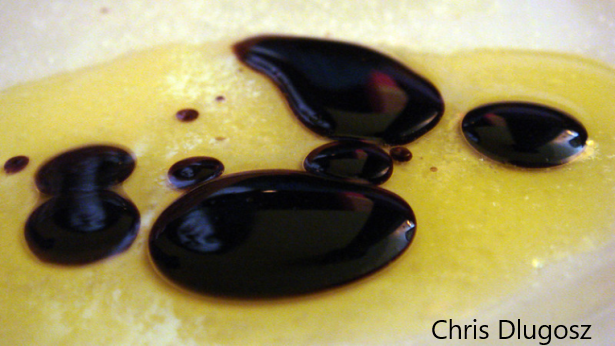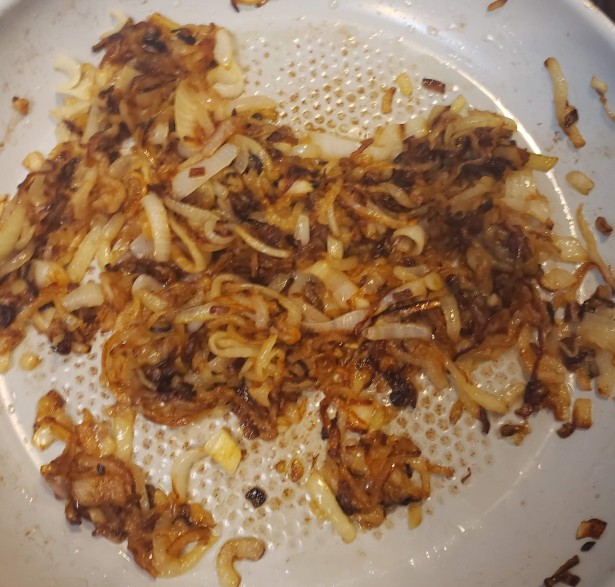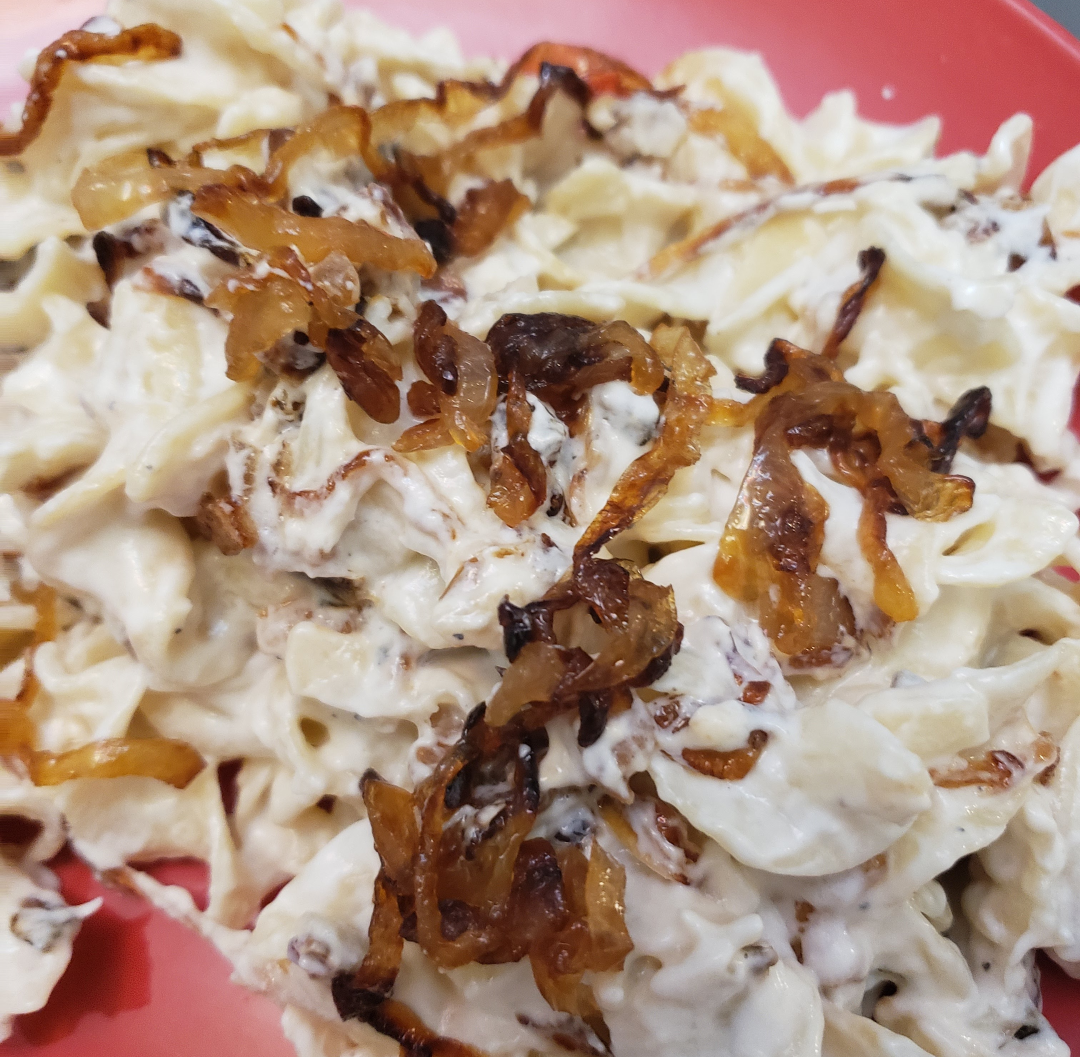KC 186 – Yogurt-Sauced Pasta

Why hello there and welcome back to Kitchen Catastrophe. I’m your Not-A-Ghost Host, Jon O’Guin, so please stop calling “Busters” to remove me from places. Today’s topic is the first in a series of this month’s pseudo-theme, “Tricks and Treats”. Because we just wrapped up two consecutive theme months, don’t expect us to be too rigid with it. Today, we’re exploring a weird trick: Yogurt as Pasta sauce. Let’s dig into it. For those of you who want to get straight to the mad science without the mad humanities, skip ahead with this link. The rest of us will make it LIVE.
It’s All Greek To Me
This recipe comes from Diane Kochilas, a Greek-American cookbook author, chef, and cooking school owner, via a secondhand-source, Food52. I’ve mentioned them several times, mostly in reference to their Genius Recipes series, which this is another entry in that long saga. The basics are…well, basic: mixing pasta water with yogurt to form a creamy sauce for pasta. That’s it.
Yes, that yogurt. In case you couldn’t remember what it looked like.
And the science involved is…something I’ve spent a lot of time alluding to, and occasionally briefly talking about, and now have decided to do a moderately deep dive on. Because Yogurt is a colloid, MADE of another colloid(actually, TWO colloids), but they’re DIFFERENT colloids, and I’ve now used the word “colloid” too many times to NOT explain it.
A colloid is a term for (And buckle in on this one, folks): “a homogenous non-crystalline substance consisting of large molecules or ultramicroscopic particles of one substance suspended in another.” That sounds really dense and confusing, but it’s really simple: Think of whipped cream. Whipped cream is just cream that has had little pockets of air whipped into it. The cream and the air are mixed together into a single THING: there’s not like, scattered bubbles of different sizes in it. And you can’t like, strain out the air. That’s an example of a foam which is a colloid of gas mixed in a liquid medium. Foams are one of 8 kinds of colloid, arranged by what’s being mixed into what. Cooking is rife with Emulsions, which are liquids mixed into other liquids: mayonnaise and vinaigrettes are both emulsons of fat and acid, while milk is an emulsion of fat and water.
Here we see a not-emulsion, which could BE an emulsion if it really tried, damn it.
Milk is actually a really interesting one, because it’s basically a colloid OF colloids: the standard understand of milk is as a pure emulsion: it’s butter fat suspended in a water-based fluid. BUT the fat doesn’t contain the milk’s protein or minerals. Those are ALSO suspended in the water, making that half of milk technically another kind of colloid, called a “sol”, where solids are dispersed in liquid form.(“sol” is, and I’m not kidding, just an abbreviation of “solution” that we decided to keeps as the word for the thing. Even the WORDS here are messy.) Another example would be Ink, where the color comes from tiny particles of Colorful solids suspended in the liquid. So milk is technically an emulsion of fat and a sol.
Take a moment to let that sink in because YOGURT is, thanks to fermenting, churning, and so on, neither an emulsion nor a sol, but rather a Gel: a SOLID containing a lot of dispersed liquids. So we took a mixture of solids and liquids, mixed into liquids, and ended up with solids full of liquids.
I’ve gone so cross-eyed the rest of my head dissolved.
If you want to understand gels with an easy example, they’re microscopic water balloons: the solid encases the liquids, and expands to hold it all. Thinner walls make for more agile gels, like those floppy water balloons that you could like, roll over your wrist and shit. I assume you all did that, otherwise that example really doesn’t help. The point is that that’s part of why some yogurts are more liquid than others: they have thinner “walls”, and a higher ratio of liquid to solid. Interestingly, and I SWEAR we’re wrapping up the science jibber-jabber with this, Yogurts might seem to violate the rules of a colloid, because you can make yogurts thicker by draining them of liquid, but you can’t fully separate them without chemically breaking them apart. Hell, yogurts actually SELF-strain: that’s why you get those puddles of whey on top of yogurt, the yogurt is squeezing some of the liquid out of itself by its OWN weight.
Aight, so we know, chemically, what’s going on with yogurt. Why is that important?
Fighting Fears
The answer to that is, basically, that most pasta sauces, especially the dairy based ones, are emulsions. Think about it. How do you make a béchamel? You thicken milk with a sol of liquid fat and flour. So why not try approaching it the other way? Instead of thickening milk, why not THIN yogurt?
Too thin! You’ve gone too far!
And because I’m getting a little loopy, let me answer my own rhetorical question, and then REBUT my answer, because I need dialogue for this to kind of flow, and I’m working on a narrow window.
There’s two solid arguments on why you might not want to thin down yogurt: the first is that yogurt is not as blank a canvas as milk is. It has a tang from fermentation that doesn’t pair well with everything. So it might not match up with your vision for the flavors you’re looking for. The second is even simpler: you’ve never done it before. Think about it, I just spent 800 words talking about sol-colloids and self-straining gels to get the roughest shape of the science involved. That’s a lot to get into with a new cooking technique. You probably get thickening milk, or reducing a sauce: get it hot, and wait until there’s less of it. But how does yogurt react to heat? Will it dissolve, the proteins denaturing and losing structure? You don’t want to screw up dinner trying something fancy.
Which is why I’m here. This is Kitchen Catastrophes, not “Kitchen Everything Goes Right”. I’m here to get you over that second challenge, and get you thinking about the first one. So yogurt has a more distinct flavor. That’s not really an argument for not using it: Puttanesca doesn’t taste like Bolognese, which doesn’t taste like Alfredo, which doesn’t taste like Vodka sauce, but they all go on Fettucine just fine. Now, if you don’t LIKE the taste of yogurt, and don’t want to use it, that’s perfectly understandable. But saying “it tastes DIFFERENT, therefore I don’t want to TRY” isn’t. You might think of yogurt just in terms of granola and fruit, but you know what else uses yogurt? Tandoori Chicken.
It can also be used with tahdig, Persian crusted rice.
You can use yogurt as a marinade or roasting crust for fish, chicken, or pork. You can mix it into anywhere that you’d use sour cream OR mayonnaise. You can use it in your Alfredo, Vodka, and Bolognese sauces, which all use SOME form of dairy. And maybe this would be a better topic for a Thursday post. Let’s get back to the main event: yogurt pasta.
A Starch is Born
Now, this is a fairly minimalistic recipe. It’s got a grand total of like, 7 ingredients. And they’re all used in pretty simple ways. The first step to your yogurt pasta is the topping: you gotta caramelize some onions. 6 CUPS of onions.
It’s less impressive looking when it’s rendered down.
I’m going to skip the pictures of the various stages of that caramelization process, but I will say this recipe used a relatively rare technique in the caramelizing game in that it slid its heat. This has you start with your oil at medium-high heat, adding the onions to get a nice initial blast of warmth before dropping it to medium-low and cooking down for the next half-hour or so. And I’m certainly not hiding my onions from you because I got confused about how they’re supposed to be prepared, and SLICED most of my onions instead of chopping them. (I even chopped the first onion, said “oh, that’s not how you prep onions,” and ‘corrected’ to slicing.)
As the onions brown up, you want to get a pound of pasta and 4 quarts of water. Or, if you’re only cooking for 2, half a pound and 2 quarts. Get the water boiling, salt it heavily, and cook the pasta, explicitly PAST al dente. You want the pasta a little soft. You’re also supposed to use tagliatelle, a thicker long Italian noodle, which, since I’m currently in Leavenworth, turned out to be unavailable unless I wanted to go on a 3 mile jog for a pound of pasta. Which may not sound so bad to you lean mean jogging machines, but…Look, I legitimately thought it was farther. I thought I was looking at 4-5 miles, and part of it’s on a tall highway bridge in the middle of drunk tourist season. So I decided to go with the closest thing I could find, Egg Noodles.
The closest thing, and the closest thing I Shot.
Boil those, and take a scoop of the hot pasta water to add to your yogurt. You actually don’t ‘Cook’ the yogurt for this sauce, instead relying on the heat of the pasta water and the starch built up in it to restructure the yogurt into something more sauce-like.
This…honestly just looks like a different kind of yogurt.
Then, you toss it with the pasta, and get to topping. Normally, a dish like this would get a shredding of Parmesan, but this recipe explicitly calls for Pecorino Romano, or a more rare Greek cheese called Kefalotyri, a word I am SUPER impressed I got correct on the first try. This is a very subtle but useful point, because both of the cheeses have something in common: they are SHEEP’S milk cheeses, not Cow’s milk. Meaning that they are a little more buttery or nutty than equivalent cheeses, to contrast the sharper base dairy.
Grate on some cheese and top with the caramelized onions, and you’ve finished the dish. Humorously, while I mentioned earlier that it’s my job to come out here and crash for your benefit, the dish was actually pretty easy to put together, other than a mild sense of panic right at the end, as you’ve got to mix the pasta water and yogurt, drain the pasta, toss the sauce and pasta, and incorporate everything in a span of like, 3-4 minutes before the pasta cools down. (Or at least, that’s what it feels like.) But in the end, it looks pretty solid.
My onions here look like a giant centipede. An ONION Centipede? No.
I took a liberty with the recipe, and added some ground black pepper to the mix as well. And we have two distinct reviews of the dish: my compatriot, Site Otaku Joe Seguin, stated it was in the Top Five foods I’ve fed him while he was intoxicated, and was quite taken with the dish. I LIKED it, but definitely felt that I could have done more with seasoning the dish: I feel I under-salted my pasta water, and therefore the overall dish, and I worry I didn’t add quite enough cheese, as I was grating it on the fly straight onto the tossed pasta. But that’s basically my only complaint: sloppy seasoning. The yogurt sauce, while tasting mostly like, well, Yogurt, definitely had the proper texture for a pasta-coating sauce, and the strands of sweeter onion through the mix gave a bit of texture and variety. As a pretty quick vegetarian meal option, I honestly think it’s a heck of a cool start to something as crazy as yogurt on pasta.
As ever, Jon’s mad culinary creations wouldn’t be possible without the support of our Patreon supporters, whose financial support keeps the site ad-free, and cover the technical costs of keeping things running. We’re also thankful to our many fans on social media, who like our posts, and share our content on Facebook, Twitter, and Instagram.
THURSDAY: MAYBE WE’LL TALK MORE ABOUT YOGURT, OR GREECE. I DON’T KNOW.
MONDAY: I MIGHT KNOW BY THURSDAY.
now, for the
Recipe
Pasta with Yogurt Sauce and Caramelized Onions
Serves 4
Ingredients
5 tbsp olive oil
6 cups coarsely chopped onions
Salt
1 pound wide pasta, such as tagliatelle
Water for boiling
2 cups Greek Yogurt (preferably “strained”, it should say so on the packaging)
1 cup grated firm sheep’s cheese, such as pecorino Romano.
Ground black pepper (optional)
Preparation
Heat the oil in a large skillet over medium high heat. Add the onion, and let sit for 20 seconds, then stir, and let set for another 15 seconds. Reduce the heat to medium-low, and cook, stirring frequently, until soft and browned, around 30 minutes, seasoning with salt to taste.
Bring your water to a boil, and just before adding your pasta, add in 2 tbsps of non-iodized salt. Add the pasta, and cook 1 minute past al dente.
Remove the pasta pot from the heat, and take a ½ cup of pasta water. Use to thin the yogurt to your desired consistency, starting with ¼ cup, and adding more if desired. Drain the pasta, and toss with the prepared sauce, adding more salt and pepper if desired. Top with the grated cheese, and 2/3rds caramelized onions. Toss again, portion onto plates, and top with remaining 1/3 of onions. Serve immediately.














